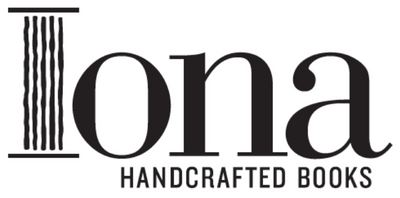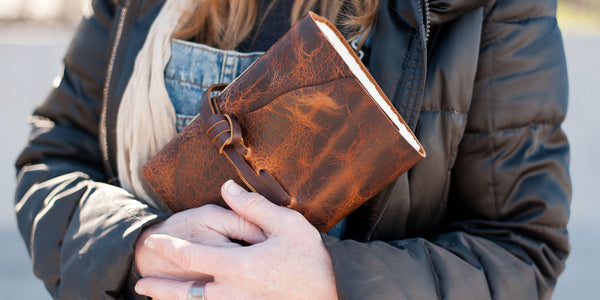Materials
Leathers:
I strive to use surplus hides when they are available. Surplus leathers come from boot, belt, and handbag makers that have hides that have more character than their customers care for. My customers appreciate that character, so I take those hides off their hands, and incorporate those marks into my designs. So you will often see small scars or "range marks" from the real life of the cow or buffalo in my books. Because of my desire to stick to mostly surplus hides, colors come and go. If you don’t see a color you had in mind, please contact me. I will do my best to help make your book dreams come true. Questions about sourcing our leather are answered on the FAQ’s page.

Papers:
Since 1994, I’ve been identifying and sourcing four perfect paper options. And honestly, they’re incredible! Each of my four paper options are acid-free, archival, and hand torn. None of the papers will bleed with any type of pen, except maybe a fat Sharpie marker... but Sharpie bleeds on everything!
The newest addition to my line: The Artisan Cotton Paper, will be replacing the Bamboo paper as my main squeeze! It is fantastic! I have been working with paper makers for the last year to create this custom paper for you from 100% cotton. It is acid free, lignin free, with a neutral ph, so it is archival quality, and ideal for family heirlooms. It is also a lovely warm antique white color that lends itself beautifully to pencil, charcoal, light watercolor, and pens of all types - including micro-tip, fountain, and calligraphy pens. There is no bleed-through. And every single page is torn by hand in my Seattle studio by me. You'll love it!
The Bamboo Paper (which is being discontinued)is made of 90% bamboo/10%cotton, and is incredibly versatile. It’s perfect for almost any kind of pencils, micro tip pens, and fountain pens. It also works well with light watercolors. It has a smoother, more consistent surface than the hemp or watercolor papers, but still has the lovely hand-torn edges that fit the traditional style of the journal. As with many custom papers, it is tricky to get consistent quality. Rather than compromise, I made the difficult decision to discontinue the Bamboo Paper due to supply chain issues that prevented me from getting the exact paper I have had for the last several years. There are still several books in the Signature Books section of the site that were made with the original Bamboo Paper. Once the ones that are currently in stock are gone, then there will be no more. So if you loved the Bamboo as I did, do a search on the site with the word "Bamboo" and all of the options will come up for you.
The Hemp Paper is the most rustic looking. It’s a blend of hemp, jute, and cotton rags, and is a good bit thinner than the watercolor paper (Ex: Mikey’s book in the Inspiration section). Since it’s thin, it makes for a more compact book, and is therefore excellent for scrapbooking or collecting memorabilia.
The Watercolor Paper is In very short supply right now due to the supply chain issues that began during the pandemic. And for that reason I have removed it as an option from most book sizes. If you would like one, please reach out to me. It is 100% cotton rag, and is designed for watercolor painting in addition to pen and ink (Ex: Benno’s book in the Inspiration section). It’s the thickest of the 4 journal papers, which is ideal as it allows for painting on both sides of the page. I am working with a papermaker now that is trying to reproduce this paper for me. So stay tuned Summer of 2025 for news about that!
The Black Paper is standard in all my photo albums. Each of the album’s 52 pages of black paper are separated by 52 pages of vellum to protect your photos from damaging one another. When your photos are mounted, the dark background really makes your photos “pop”!

Hardware:
The hardware pieces that I use as embellishment or as closure mechanisms are all true antique pieces. I do a lot of digging through piles of junk in basements, and flea markets, and tiny "mom and pop" shops along little highways throughout this beautiful country (and when I travel abroad, I do the same). I am mostly attracted to pieces that are from the late 1800's, and I never use any reproductions. Some pieces come to me rusted, or frozen, so I spend many hours loosening, sanding, and finishing them before attaching them to the books with hand-hammered copper rivets. Every single piece is a little piece of history. The loving attention to detail from a past era. A time when the little flourishes were worth the time it took to craft them. They really make me happy!

 Visit our FAQ if you have any questions or reach out to us directly!
Visit our FAQ if you have any questions or reach out to us directly!


